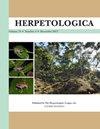夜行蛙的日间鸣叫:巴拿马塔博加岛上Túngara蛙(Engystomops pustlosus)的特殊鸣叫活动
IF 1.1
3区 生物学
Q2 ZOOLOGY
引用次数: 2
摘要
摘要众所周知,Túngara蛙(Engystomops pustulosus)在捕食者面前可以降低叫声的复杂性。尽管复杂的叫声对雌性更有吸引力,但它们也会吸引捕食者,尤其是吃蛙的蝙蝠,而且很少被孤独的雄性发出。因此,如果Túngara蛙要从捕食压力中解脱出来,就像在巴拿马湾的塔博加岛上一样,那里没有吃蛙的蝙蝠,那么这种对鸣叫的限制应该得到缓解。我们使用定时视频记录,将塔博加的Túngara蛙的叫声行为与巴拿马中部的巴罗科罗拉多岛上的青蛙的叫声行为进行了比较。与巴罗科罗拉多岛上的Túngara蛙相比,塔博加岛上的雄性Túngara蛙叫声更多,在合唱中发出的叫声持续更多,并且昼夜都在鸣叫。在塔博加,即使是孤独的雄性也经常用查克元素来修饰它们的叫声。这些结果与捕食者释放对呼叫行为产生积极影响的假设一致。本文章由计算机程序翻译,如有差异,请以英文原文为准。
Diurnal Calling in a Nocturnal Frog: Exceptional Calling Activity of Túngara Frogs (Engystomops pustulosus) on the Panamanian Island of Taboga
Abstract Túngara Frogs, Engystomops pustulosus, are known to reduce the complexity of their calls in the presence of predators. Although complex calls are more attractive to females, they also attract predators, particularly frog-eating bats, and are rarely emitted by solitary males. Therefore, if Túngara Frogs were to be released from predation pressure, as on the island of Taboga in the Gulf of Panama where frog-eating bats are absent, such constraints on calling should be alleviated. We compared the calling behavior of Túngara Frogs on Taboga with the calling behavior of those on Barro Colorado Island, located in central Panama where frog-eating bats are present, using timed video recordings. Compared with Túngara Frogs on Barro Colorado Island, male Túngara Frogs on Taboga called more, emitted consistently more calls in choruses, and called both day and night. On Taboga, even solitary males routinely embellished their calls with chuck elements. These results are consistent with a hypothesis of predator release positively affecting calling behavior.
求助全文
通过发布文献求助,成功后即可免费获取论文全文。
去求助
来源期刊

Herpetologica
生物-动物学
CiteScore
4.60
自引率
0.00%
发文量
27
审稿时长
>12 weeks
期刊介绍:
Established in 1936, Herpetologica is a quarterly peer-reviewed journal serving herpetologists, biologists, ecologists, conservationists, researchers and the scientific community. The journal contains original research papers and essays about the biology of reptiles and amphibians, and covers many relevant topics including: behavior, conservation, ecology, genetics, morphology, physiology and taxonomy.
 求助内容:
求助内容: 应助结果提醒方式:
应助结果提醒方式:


